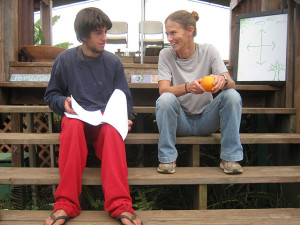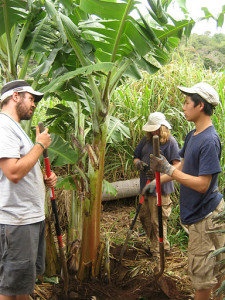By Hilary Moses, Therapeutic Program Director
Our focus on maintaining a high quality of care is always in motion and is invigorated every Monday morning in a meeting with the field supervisors, the therapeutic program director and the staff supervisor; it also includes a drop in visit from Al, PQ’s RN. During this meeting, the field supervisors review the time they spent with the students and field staff in each camp between Thursday and Monday (our field work week is from Thursday to Thursday). During our weekly meeting, the supervisor team  reviews therapeutic outcomes and strategies that are being implemented in the field. The goal of the meeting is to assess what has been useful, and which strategies need to be “composted” to make room for new ones to be planted and cultivated. The supervisors review the peer group dynamic, healthy and unhealthy relationships that are budding and ways to utilize such observations for ongoing development. The field staff help students develop insight into how these relationships mirror ones at home, how they benefit from the relationship and how they are negatively affected. Additionally, we review apparent “roses and thorns”(strengths and struggles) observed in the staff, we identify what students the staff work best with, how they can work together as a team, and what are their growth areas to be reviewed during weekly training, etc… This is such a great collaborative experience that I am so excited to be a part of!
reviews therapeutic outcomes and strategies that are being implemented in the field. The goal of the meeting is to assess what has been useful, and which strategies need to be “composted” to make room for new ones to be planted and cultivated. The supervisors review the peer group dynamic, healthy and unhealthy relationships that are budding and ways to utilize such observations for ongoing development. The field staff help students develop insight into how these relationships mirror ones at home, how they benefit from the relationship and how they are negatively affected. Additionally, we review apparent “roses and thorns”(strengths and struggles) observed in the staff, we identify what students the staff work best with, how they can work together as a team, and what are their growth areas to be reviewed during weekly training, etc… This is such a great collaborative experience that I am so excited to be a part of!
As the Therapeutic Program Director, I get to have a hand in the strategies that are implemented by field staff, field supervisors, and clinicians in order to best serve every student that comes to our program. My role at PQ really plays to my strengths of taking abstract goals, varying personalities and situations and developing hands-on, concrete and creative interventions for teaching. Being involved in the Monday meeting allows me to participate in a weekly growth experience, and to learn from four smart and creative people with lots of experience. I am continually challenged to get out of my typical “go to” strategies and to think of pros and cons of different ideas.
meeting allows me to participate in a weekly growth experience, and to learn from four smart and creative people with lots of experience. I am continually challenged to get out of my typical “go to” strategies and to think of pros and cons of different ideas.
A piece of best practices includes ongoing assessment and review of the services delivered and of those who are delivering the services. As a result of our weekly meetings we get real time feedback and the opportunity to implement real time interventions for our staff and students. Knowing that this is part of the ongoing process of the program, we have learned that we tend to invite staff who are open to and actively working on their own growth; personalities that are more guarded and less open to role modeling the ongoing need for growth tend to be weeded out of our staff team relatively quickly.
One soapbox that I have carried with me over the years in this industry is the importance of giving equal value, if not more value, to the field department as we do to the clinical department. While the clinician plays an important role and is often the one to whom a student is referred, the field staff role augments that of the clinicians. In a “Rainbow Brite” comic I was recently reading to my kids, one character had a superpower bracelet, but it needed the rainbow power of “Brite’s” belt to give it the extra “umph” to allow it to reach its full potential. The clinicians are the bracelet, the field staff are “Rainbow Brite”, and sometimes vice versa. The fact is that all roles are vital but that the majority of the work happens in the field, in the garden, with the field staff. As a result, I am working in this new role as the Therapeutic Program Director, to develop deeper ties and a stronger bridge between the clinical and field departments.
Another fact is that most parents are unaware of how comprehensive a Sustainable Growth™ program like ours is with all of its members. We are frequently asked why we only see the students for therapy twice a week, or rather, why they are paying so much if we are not seeing the students more frequently. What is integral in understanding the breadth of what we offer is what happens day in and day out at Pacific Quest wilderness therapy program that leads to this quality of care.